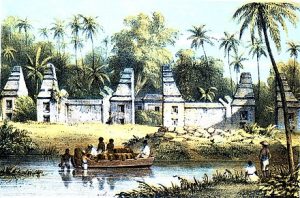The Age of Islamic States
The spread of Islam
The earliest accounts of the Indonesian archipelago date from the Abbasid Caliphate, according to those early accounts the Indonesian archipelago were famous among early Muslim sailors mainly due to its abundance of precious spice trade commodities such as nutmeg, cloves, galangal and many other spices.

Although Muslim traders first travelled through South East Asia early in the Islamic era, the spread of Islam among the inhabitants of the Indonesian archipelago dates to the 13th century in northern Sumatra. Although it is known that the spread of Islam began in the west of the archipelago, the fragmentary evidence does not suggest a rolling wave of conversion through adjacent areas; rather, it suggests the process was complicated and slow. The spread of Islam was driven by increasing trade links outside of the archipelago; in general, traders and the royalty of major kingdoms were the first to adopt the new religion.
Other Indonesian areas gradually adopted Islam, making it the dominant religion in Java and Sumatra by the end of the 16th century. For the most part, Islam overlaid and mixed with existing cultural and religious influences, which shaped the predominant form of Islam in Indonesia, particularly in Java. Only Bali retained a Hindu majority. In the eastern archipelago, both Christian and Islamic missionaries were active in the 16th and 17th centuries, and, currently, there are large communities of both religions on these islands.
Sultanate of Mataram
The Sultanate of Mataram was the third Sultanate in Java, after the Sultanate of Demak Bintoro and the Sultanate of Pajang.

According to Javanese records, Kyai Gedhe Pamanahan became the ruler of the Mataram area in the 1570s with the support of the kingdom of Pajang to the east, near the current site of Surakarta (Solo). Pamanahan was often referred to as Kyai Gedhe Mataram after his ascension.
Pamanahan’s son, Panembahan Senapati Ingalaga, replaced his father on the throne around 1584. Under Senapati the kingdom grew substantially through regular military campaigns against Mataram’s neighbours. Shortly after his accession, for example, he conquered his father’s patrons in Pajang.
The reign of Panembahan Seda ing Krapyak (c. 1601–1613), the son of Senapati, was dominated by further warfare, especially against powerful Surabaya, already a major centre in East Java. The first contact between Mataram and the Dutch East India Company (VOC) occurred under Krapyak. Dutch activities at the time were limited to trading from limited coastal settlements, so their interactions with the inland Mataram kingdom were limited, although they did form an alliance against Surabaya in 1613. Krapyak died that year.
Krapyak was succeeded by his son, who is known simply as Sultan Agung (“Great Sultan”) in Javanese records. Agung was responsible for the great expansion and lasting historical legacy of Mataram due to the extensive military conquests of his long reign from 1613 to 1646.
Sultanate of Banten
In 1524–25, Sunan Gunung Jati from Cirebon, together with the armies of Demak Sultanate, seized the port of Banten from the Sunda kingdom, and established The Sultanate of Banten. This was accompanied by Muslim preachers and the adoption of Islam amongst the local population. At its peak in the first half of the 17th century, the Sultanate lasted from 1526 to 1813 AD. The Sultanate left many archaeological remains and historical records.

